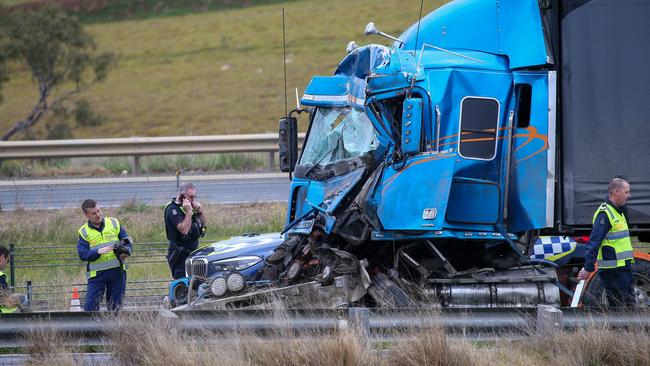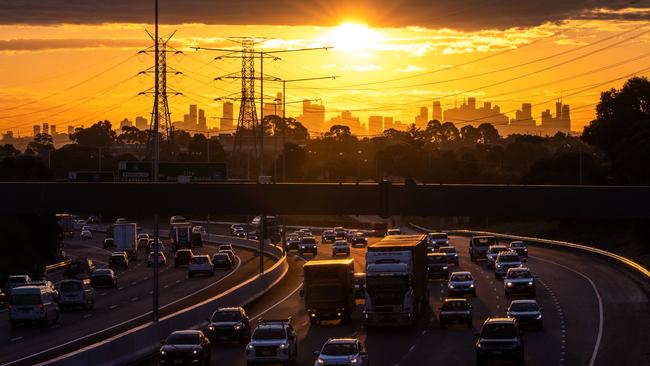Shocking number of sleep-deprived truckies on Victoria’s roads revealed
The number of dangerously fatigued truck drivers on Victoria’s roads has been revealed, with greed being blamed for the life-threatening hazard.

Victoria
Don't miss out on the headlines from Victoria. Followed categories will be added to My News.
More than 1000 cases of dangerously fatigued truck drivers were detected on Victorian roads last year.
The shocking figures from the National Heavy Vehicle Regulator reveal some drivers have been busted more than 10 times for being too tired behind the wheel.
The Transport Workers Union said the alarming fact an average of three dog-tired truckies were being caught on Victorian roads each day was caused by “untrammelled commercial pressure”.
Some breaches were exposed by logbook compliance checks and others via calls to a heavy vehicle reporting line.
The weary truckie numbers are on top of 306 serious defect notices issued by the NHVR for issues like faulty brakes, failing steering and worn-out suspensions.

The transport watchdog said the vast majority of the nation’s 270,000 heavy vehicle operators took safety seriously, but the TWU said there was clearly an element that did not.
The TWU’s Victoria and Tasmania secretary Mike McNess, said money-hungry employers often forced truck drivers to fake their logbook hours and skip breaks.
“It’s saddening but not surprising to see that fatigued truck drivers are on the road,” he said.
“The problem stems from untrammelled commercial pressure from the wealthy owners of freight who squeeze transport contracts, reaping every dollar of margin from operators and drivers.”
A 2021 TWU survey found that employers had pressured one in four truck drivers to work beyond legal hours and skip breaks.
A quarter of drivers said they had been told to falsify working hours in their logbooks.
Mr McNess said the pressure on truckies was “deadly”.
“We need to eradicate pressure on drivers to work fatigued, delay maintenance and engage in other dangerous cost-cutting measures,” he said.
A number of high-profile incidents have brought industry safety to the forefront in recent years.
In April 2020, sleep-deprived and drug-affected truck driver Mohinder Singh killed four on-duty police officers when he veered into the emergency lane of the Eastern Freeway. Singh, who had slept for just five hours in three days and thought a witch was chasing him in the lead-up to the crash, was sentenced to a maximum of 18½ years in jail.

In September last year, a school bus carrying a group of students from Loreto College in Ballarat tumbled down a hill on the Western Freeway in Bacchus Marsh when a B-double truck transporting bags of sand crashed into it from behind.
The crash injured dozens of students, including one who needed surgery to save a leg.
Police last month alleged that 60-year-old truck driver Brett Russell, who faces almost 50 charges over the wreck, opted to ignore his truck’s brake failures.
The NHRV figures from last year showed its safety and compliance officers had intercepted 9654 heavy vehicles, frequently in targeted operations based on data and intelligence.
Of those, there were 2281 defect notices issued, 309 of which were for major defects, which are described as problems presenting an “imminent and serious safety risk”.

Another 779 minor defects and 1193 over self-clearing defects were detected.
“Vehicle conditions that may constitute a major defect include faulty brakes, severely worn steering components, severely worn suspension components, cracks in the chassis, severely worn tow couplings or tyres worn to the points of exposing the inner steel cords,” an NHRV spokeswoman said.
Officers did 137 “roadside educations” last year.
NHVR chief executive Sal Petroccitto said the industry was increasingly adopting and investing in procedures to create a safer and more productive sector.
“Safety requires a whole-of-business approach, including pre-trip checks, ensuring vehicles are safe to operate on the road and that drivers are fit for duty,” Mr Petroccitto said.
Victorian Transport Association chief executive Peter Anderson said most operators complied with driver and vehicle safety checks, but a small minority did the sector a “huge disservice” by putting others at risk.
He said it was sometimes necessary to turn down jobs from customers wanting goods delivered if it meant preventing accidents and saving lives.
“Operators and drivers have an obligation to themselves, their families and other road users to be safe, legal, and compliant, so any fatigue or defect breach is concerning,” he said.
“Labour shortages and soaring demand for freight services may be a factor in some of these breaches with operators under pressure to deliver, but there is no excuse for fatigued drivers and unsafe vehicles.”




